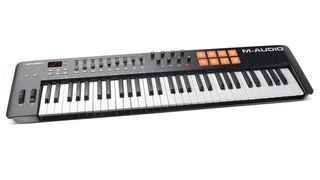M-Audio’s Oxygen 61 is a solid entry-level MIDI controller, with an array of useful MIDI controls and features. Its no-nonsense, plug-and-play capability makes it easy to instantly start creating.
This latest iteration of M-Audio’s Oxygen controller opts for a slightly different design than its predecessor, moving the pitch and mod wheels to the left of the keyboard. This feels more natural than the previous Oxygen model, which positioned the pitch and mod wheels above the keyboard.
The back of the controller is quite concise, featuring a USB and sustain pedal jack. The new Oxygen series doesn’t incorporate a MIDI jack, so you’ll have to use an external MIDI interface if you want to control any peripheral devices, such as analogue synths or drum machines. However, if you want a keyboard that you can dive right into without any additional setup, this is the controller for you.
- The best MIDI keyboards for beginner and pro musicians
- Best synthesizers: keyboards, module and semi-modular synths
- Best pianos: acoustic and digital pianos for beginners and pros

The Oxygen 61’s control surface features a small LED readout on the left, showing the value of the most recently moved MIDI control. This is coupled with patch selection controls, “Shift” and “Edit” buttons for extended controller functionality, and an “Auto” button to auto-assign controls within your DAW.
To the right of the LED area, the Oxygen 61 sports 9 MIDI faders and control toggles, 8 directional MIDI knobs, and brief transport controls. It also boasts 8 velocity-sensitive, backlit drum pads, a new feature for the Oxygen series. In the box, you’ll also find a free download for Ableton Live 9 Lite, which works seamlessly with the controller’s “auto-assign" function.
In the field
The aforementioned auto-assign feature is extremely useful, making it easy to integrate this controller with all major DAWs. The new Oxygen 61 is simply a hassle-free, quick-on-the-draw music creation tool.
The Oxygen 61 has switched up its faders from the previous generation, where large rubber fixtures jutted vertically from the surface of the keyboard on each fader. These new faders are nearly flush with the keyboard’s control surface, so the fixtures are far less likely to become lost or break off. However, both the faders and the control surface are made of black plastic now, so it’s a little difficult to see their positioning at first glance.
The same holds true for the Oxygen’s MIDI knobs. While the previous generation had a white notch showing knob position, this notch is now incorporated into the design of the knob. While the notch is completely visible in normal light, and works great for home/studio use, stage performances and other low-light environments may not be ideal for this controller.
The addition of drum pads is a huge boost for the Oxygen series. The drum pads light up upon impact and can be mapped to MIDI notes and CCs. This makes the pads extremely useful in all contexts, whether you’re controlling a drum plugin or toggling MIDI effects.
The transport controls allow you to directly take command of your DAW. The previous iteration of the Oxygen featured forward and rewind buttons, which have been omitted in this new model. While these are often the least used transport controls, I typically would use them to shuttle back and forth between patches in programs like Apple Mainstage. However, with the addition of the drum pads, these can now be mapped as forward/rewind buttons or patch selectors instead.
The Oxygen 61 features a light action, so experienced keyboardists will be able to fly on this controller. I usually prefer an action with a little more weight and depth, but as mentioned before, this keyboard is more suitable for studio use over live use. The action is certainly sturdy enough to produce a smooth, dynamic performance, although I found a slightly uneven drop-off at MIDI velocities below 20. All-in-all, the M-Audio Oxygen 61 has great value as a controller for your home, studio, or production setup.
[EDITOR'S NOTE: M-Audio's entire lineup of current products comes with M-Audio Pro Tools First, the only version of Pro Tools First that works with their VST instruments. Products are also bundled with:
The above bundle is free to download when users register their keyboard at http://maudio.com/account/create]

